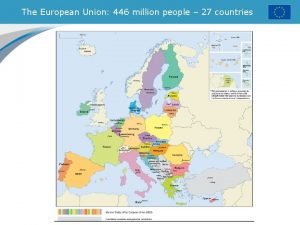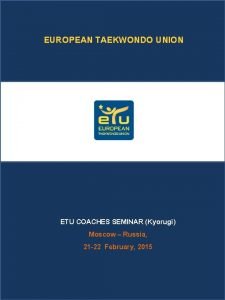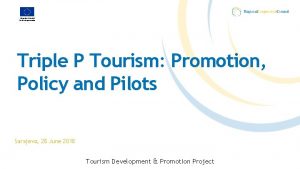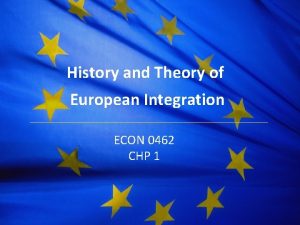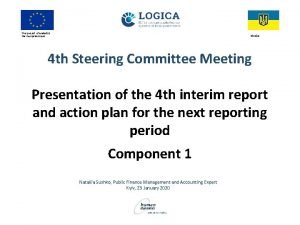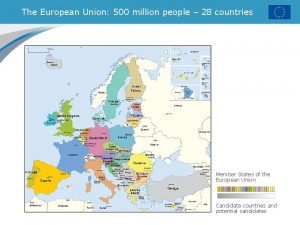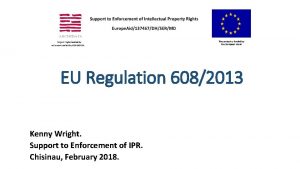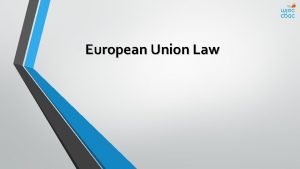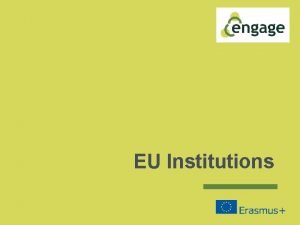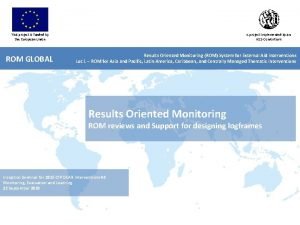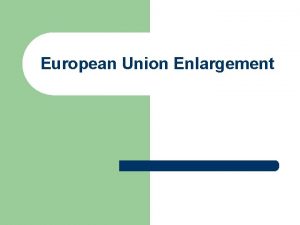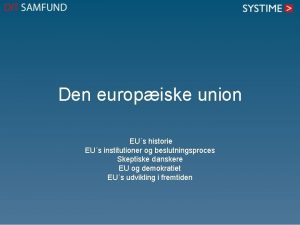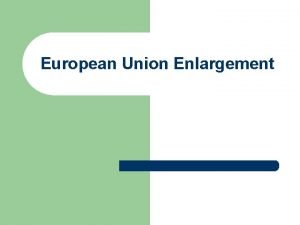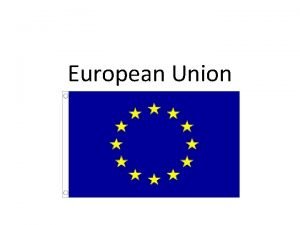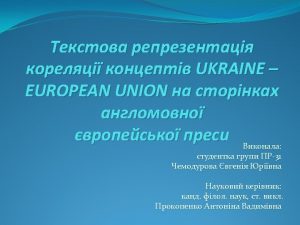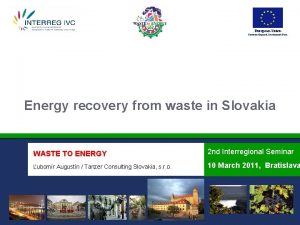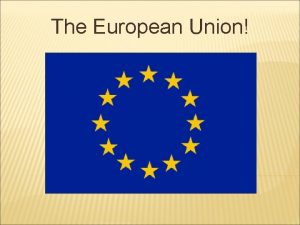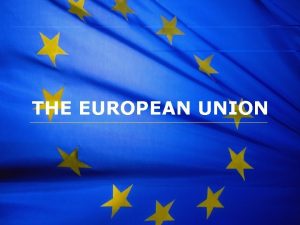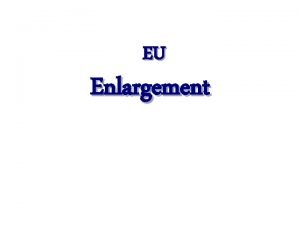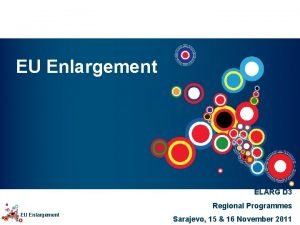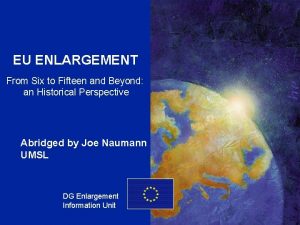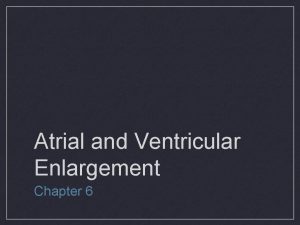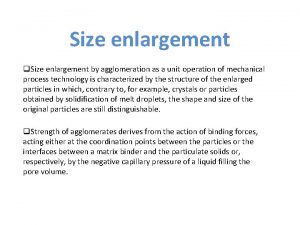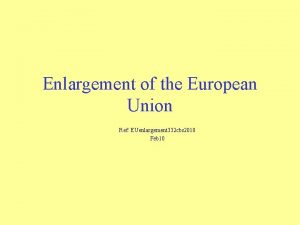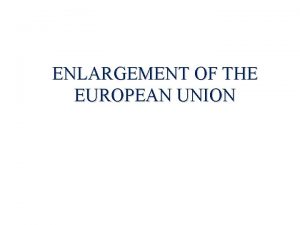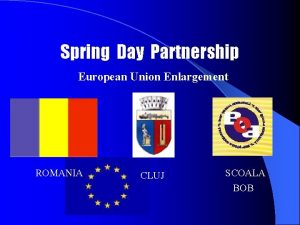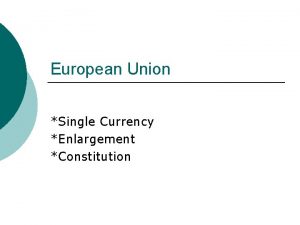European Union Enlargement Agenda 1 The EUs enlargement



























































- Slides: 59

European Union Enlargement

Agenda 1. The EU’s enlargement policy 2. Legal basis 3. Steps towards joining EU 4. Special process for Western Balcans 5. Actors in the enlargement process 6. From 6 to 28 members 7. Acceding countries

The EU’s enlargement policy „The EU’s enlargement policy contributes to mutual benefits of peace, security and prosperity in Europe. It reinforces the EU’s political and economic strength and has a powerful effect on the countries concerned. ” (Enlargement Strategy and Main Challenges 2014– 2015 )

The EU’s enlargement policy „When it comes to enlargement, I fully recognise that this has been an historic success that brought peace and stability to our continent. However, the Union and our citizens need to digest the addition of 13 Member States in the past 10 years. The EU needs to take a break from enlargement… ” (Jean-Claude Juncker, A New Start for Europe: My Agenda for Jobs, Growth, Fairness and Democratic Change, )

The EU’s enlargement policy Support for the EU’s enlargement - data Źródło: Public Opinion in the EU, Standard Barometer, Spring 2014

Legal basis Treaty on European Union, Article 2 „The Union is founded on the values of respect for human dignity, freedom, democracy, equality, the rule of law and respect for human rights, including the rights of persons belonging to minorities. These values are common to the Member States in a society in which pluralism, non-discrimination, tolerance, justice, solidarity and equality between women and men prevail. ”

Legal basis Treaty on European Union, Article 49 „Any European State which respects the principles set out in Article 6 (1) may apply to become a member of the Union. It shall address its application to the Council, which shall act unanimously after consulting the Commission and after receiving the assent of the European Parliament, which shall act by an absolute majority of its component members. ” (1) Principles are set out in the Charter of Fundamental Rights of the EU, they are divided into 6 groups: dignity, freedoms, equality, solidarity, citizens’ rights and justice.

Steps towards joining EU European Union Association Agreement l l l treaty between the EU and a non-EU country that creates a framework for cooperation between them; areas covered by such agreements include the development of political, trade, social, cultural and security links; in certain cases, they prepare for future membership of the European Union (eg. Poland, Hungary-1994; Romania, Bulgaria, Czech Republic-1995; Estonia, Lithuania, Latvia 1998; Slovenia-1999 – none of them is in force).

Steps towards joining EU Process 1 2 3 4 5 6 7 8 • • Application for membership Initial evaluation of the applicant country Granting a status of the candidate country Opening of negotiations Negotiations (and screening) Accession treaty Ratification Acceding country becomes EU member state

Steps towards joining EU Process – application for membership 1) The applicant country (potential candidate) submits application to the country holding the rotating presidency of the Council of the European Union.

Steps towards joining EU Process – initial evaluation of the applicant country 2) The European Commission makes an initial evaluation of the applicant country and submits findings to the Council of the European Union.

Steps towards joining EU Process – granting a status of the candidate country 3) If the European Commission has a favourable opinion of the applicant country’s status, the Council of the European Union may decide to consider the applicant a candidate country.

Steps towards joining EU Process – opening of negotiations 4) The decision to open negotiations is made through a unanimous vote of the Council. A positive opinion from the Commission on the candidate’s compliance with the Copenhagen criteria is essential in practice although not formally required.

Steps towards joining EU Process – Copenhagen criteria Countries wishing to join need to have: l stable institutions guaranteeing democracy, the rule of law, human rights and respect for and protection of minorities; l a functioning market economy and the capacity to cope with competition and market forces in the EU; l the ability to take on and implement effectively the obligations of membership, including adherence to the aims of political, economic and monetary union.

Steps towards joining EU Process – Copenhagen criteria The Union's capacity to absorb new members, while maintaining the momentum of European integration, is also an important consideration in the general interest of both the Union and the candidate countries.

Steps towards joining EU Process – screening and negotiations 5) The European Commission investigates the candidate country in detail in a process known as screening. The resulting screening report identifies the gaps in the body of common rights and obligations binding for all EU Member States (acquis) that the candidate country will have to fill. The conclusion of this report is a recommendation of the Commission to either open negotiations directly or to require that certain conditions – opening benchmarks - should first be met.

Steps towards joining EU Process – negotiations and screening Before negotiations can start, the candidate country must submit its negotiating position and the EU must adopt a common position. The pace of the negotiations depends on the speed of reform and alignment with EU laws in each country. The duration of negotiations can vary – starting at the same time as another country is no guarantee of finishing at the same time.

Steps towards joining EU Process – negotiations and screening The Council, acting by unanimity, invites the candidate country to open negotiations on the 35 negotiation chapters (policy fields) covering the entirety of the EU acquis. Negotiations, conducted by the Council Presidency, take place in an Accession Conference. The Commission plays an important role as facilitator with respect to helping solve any problems the candidate country may face during the negotiations. The EP Foreign Affairs Committee holds regular exchanges of views with EU negotiators and those of candidate countries.

Steps towards joining EU Negotiations chapters 1. Free movement of goods 2. Freedom of movement for workers 3. Right of establishment an freedom to provide services 4. Free movement of capital 5. Public procurement 6. Company law 7. Intellectual property law 8. Competition policy 9. Financial services 10. Information society and media 11. Agriculture 12. Food safety, veterinary, phytosanitary 13. Fisheries 14. Transport policy 15. Energy 16. Taxation 17. Economic and monetary policy 18. Statistics 19. Social policy and employment 20. Enterprise and industrial policy 21. Trans-European Networks 22. Regional policy and coordination of structural instruments 23. Judiciary and fundamental rights 24. Justice, freedom and security 25. Science and research 26. Education and culture 27. Environment 28. Consumers and health protection 29. Customs union 30. External relations 31. Foreign security and defence policy 32. Financial control 33. Financial and budgetary provisions 34. Institutions 35. Other issues

Steps towards joining EU Process – negotiations and screening The candidate country does not „negotiate” on the acquis communautaire itself as these rules must be fully adopted by the candidate country. The negotiation aspect is on the conditions for harmonisation and implementation of the acquis, that is, how the rules are going to be applied and when.

Steps towards joining EU Process – accession treaty 6) After the candidate country has reformed its national laws so that they match the acquis, every criterion has been fulfilled, and every chapter has been closed, the agreements reached are set out in an accession treaty, which must be signed by the candidate country and all EU Member States. The accession treaty must also win the support of the Council of the European Union, the European Commission, and the European Parliament. The candidate country then becomes an acceding country.

Steps towards joining EU Process – ratification 7) After the accession treaty has been signed, it must be ratified by the acceding country and each individual EU Member State according to their constitutional rules (i. e. parliamentary vote, referendum).

Steps towards joining EU Process – acceding country becomes EU member state 8) The acceding country then becomes an EU Member State on the date specified in the accession treaty.

Special process for Western Balkans Stabilization and association process l special framework which has 3 aims: - stabilising the countries politically and encouraging their swift transition to a market economy, - promoting regional cooperation, - eventual membership of the EU; l the process helps the countries build their capacity to adopt and implement EU law, as well as European and international standards. It is based on an evercloser partnership (trade concessions, economic and financial assistance, assistance for reconstruction, development and stabilisation).

Actors in the enlargement proccess The Council of the European Union • receives application, considers requests, request opinion from the Commission gives negotiation mandate to the Commission adopts European partnerships/SAAs/Accession Partnership approves draft Accession Treaty • budgetary authority together with European Parliament • • •

Actors in the enlargement proccess The • • European Commission political dialogue prepares opinion on accession negotiates SAAs/Accession Partnerships financial assistance (IPA) monitoring (regular reports, peer reviews) screening prepares negotiation positions for Accession Treaty

Actors in the enlargement proccess The • • gives consent to Accession Treaty budgetary authority (with Council) European Parliament

Actors in the enlargement proccess Member • “negotiate” and sign Accession Treaty States

From 6 to 28 members Enlargement history 1952 1990 1973 1995 1986 1981 2004 2007 2013

From 6 to 28 members European Coal and Steel Community (ECSC) • 9 th May 1950 - the Schuman Declaration, (proposition of creation of the ECSC, whose members would pool coal and steel production); • aim: economic development and political stability; • 18 th April 1951 - Treaty establishing the European Coal and Steel Community (the Treaty expired on 23 July 2002); • founding states: France, Germany, Italy, Belgium, Luxembourg and the Netherlands.

From 6 to 28 members European Economic Community (EEC) European Atomic Energy Community (EURATOM) • 25 th March 1957 – the „Treaties of Rome”, creating the European Economic Community (EEC) and the European Atomic Energy Community (EURATOM); • signed by France, Germany, Italy, Belgium, Luxembourg and the Netherlands; • EEC Treaty: establishment of a common market, customs union, development of common policies; • EURATOM Treaty: contribution to the formation and development of Europe's nuclear industries, development of atomic energy, ensuring security of supply.

From 6 to 28 members First enlargement – Denmark, Ireland UK • 22 nd January 1972 - signature by Denmark, Ireland, Norway and the United Kingdom, of the Treaties of accession to the European Communities; • the accession of Norway was rejected by the Norwegian electorate (53, 5 % against) in referendum; • 1 st January 1973 - Denmark, Ireland the United Kingdom join the European Communities.

From 6 to 28 members Second enlargement – Greece, Spain and Portugal • so called „Mediterranean enlargement”; • stability on the southern periphery of western Europe was a particular concern of France and West Germany; • aim: consolidatation of democracy and guard against a resurgence of authoritarianism, political and economical stability.

From 6 to 28 members Second enlargement – Greece, Spain and Portugal • 1974 - overthrow of the Greek military regime and restoration of democracy which enabled Greece’s application for membership; • 28 th May 1979 - Treaty of accession to the European Communities; • 1 st January 1981 - Greece join the European Communities on very favourable conditions.

From 6 to 28 members Second enlargement – Greece, Spain and Portugal • 1974 - „Third Republic” in Portugal, implementation of broad democratic reforms; • 1975 - death of Francisco Franco in Spain and the beginning of Spanish transition to democracy; • 12 th June 1985 - Signature of the Accession Treaties of Spain and Portugal; • 1 st January 1986 - Spain and Portugal join the European Communities.

From 6 to 28 members Third enlargement – Austria, Finland Sweden • 24 -25 th June 1994 - the Acts of Accession of Austria, Sweden, Finland Norway are signed; • 28 th November 1994 - the Norwegian referendum rejects accession to the European Union (other countries in favour of EU accession); • 1 st January 1995 - Austria, Finland Sweden become members of the European Union.

From 6 to 28 members Fourth enlargement – Czech Republic, Estonia, Cyprus, Latvia, Lithuania, Hungary, Malta, Poland, Slovakia, Slovenia, Romania and Bulgaria • the largest single expansion of the European Union, in terms of territory, number of states and population; • 16 th April 2003 - the Treaty of Accession between the EU and the Czech Republic, Estonia, Cyprus, Latvia, Lithuania, Hungary, Malta, Poland, Slovenia, and Slovakia is signed in Athens, Greece; • 1 st May 2004 - the Accession Treaty enters into force and the European Union's biggest enlargement ever becomes a reality with 10 new countries.

From 6 to 28 members Fourth enlargement – Czech Republic, Estonia, Cyprus, Latvia, Lithuania, Hungary, Malta, Poland, Slovakia, Slovenia, Romania and Bulgaria • 1989 – overthrow of the dictatorial regime in Romania and the beginning of political and economic transition; • 1989 - the Communist Party gave up its political monopoly in Bulgaria and Bulgaria embarked on a transition to a parliamentary democracy; • 13 th April 2005 - the Treaty of Accession between the EU and Romania, and Bulgaria; • 1 st January 2007 – Romania and Bulgaria become members of the European Union.

From 6 to 28 members Fifth enlargement – Croatia • 2003 – Croatia’s application for EU membership; • problems: long-standing border issues with Slovenia (Piran Bay boundary, between 12. 2008 and 10. 2009 Slovenia blocked Croatia's EU accession); • 9 th December 2011 – the Treaty of the Accession between the EU and Croatia; • 1 st July 2013 – Croatia joins the EU.

Acceding countries Canditate countries: 1) Iceland – negotiations started (put on hold) 2) Montenegro – negotiations started 3) Turkey – negotiations started 4) The former Yugoslav Republic of Macedonia 5) Serbia 6) Albania Potential candidates: 1) Bosnia and Herzegovina 2) Kosovo

Acceding countries Iceland - data • population – 323 810, • area – 103 001 km 2 , • GDP in 2012 - 13 billion USD, • well intergrated with EU, prior to 2009 was a member of many EU and international organisations i. e. European Economic Area (EEA), Schengen Area, European Free Trade Association (EFTA) and North Atlantic Treaty Organization (NATO).

Acceding countries Iceland EU - history 1970 – Iceland joins European Free Trade Association (EFTA); 1973 – Free trade agreement with the European Community; 1994 – Iceland joins European Economic Area (EEA); 2009 – Iceland applies to join EU and European Council requests Commission opinion on application;

Acceding countries Iceland EU - history 2009 – Icelandic ambassador to EU appointed Chief Negotiator for accession talks; 2010 – Council decides to open negotiations with Iceland; 2010 -2012 – screening process and negotiations on chapters; 2013 – Parliamentary elections in Iceland suspension of negotiations.

Acceding countries Enlargement package Each year the Commission adopts its "Enlargement package" - a set of documents explaining its policy on EU enlargement. Most importantly, this package includes the annual Enlargement Strategy Paper (last document: Enlargement Strategy and Main Challenges 2014 -2015) which sets out the way forward for the coming year and takes stock of the progress made over the last twelve months by each candidate country and potential candidate.

Acceding countries Progress Reports In addition to this strategy paper, the package contains the so-called Progress Reports in which the Commission services present their assessment of what each candidate and potential candidate has achieved over the last year.

Acceding countries Iceland’s Progress Report (2012) • suspension of the accession negotiations unless approved through a referendum; • by May 2013 27 negotiation chapters have been opened, of which 11 have been provisionally closed; • Iceland has already reached a high level of alignment in a significant number of policy areas covered by the acquis.

Acceding countries Iceland’s Progress Report • as a well-established and functioning democracy, Iceland continues to fully meet the political criteria for EU membership; • Iceland is an important economic partner for the EU through its membership of the European Economic Area (capital movement restrictions are a substantial impediment to investment and growth, lifting these controls while preserving exchange rate stability remains a key challenge).

Acceding countries Montenegro - data • population – 625 266, • area – 13 812 km 2 , • GDP in 2012 – 4, 3 billion USD, • Montenegro is a candidate country for membership of the EU, its European perspective was reaffirmed by the Council in June 2006 after the recognition of the country's independence by EU Member States.

Acceding countries EU and Montenegro - history 2006 – Montenegrin Parliament declares independence following 21 May referendum, in which 55, 5 % of participants voted in favour of independence; 2007 – EU Council decision on the adoption of a new European Partnership with Montenegro; 2007 – Montenegro signed Stabilisation and Association Agreement (SAA) and Agreements on trade and trade-related issues;

Acceding countries EU and Montenegro - history 2008 – Agreements on trade and trade-related issues, visa facilitation and readmission enter into force; 2008 – Montenegro applies for EU membership; 2010 – Stabilisation and Association Agreement (SAA) enters into force; 2012 – Accession negotiations with Montenegro started on 29 th June 2012.

Acceding countries Montenegro’s Progress Report (2013) • Montenegro continues to sufficiently meet the political criteria for EU membership; • Montenegro has made further progress towards a functioning market economy and should be able to cope with competitive pressures within the EU provided that it continues to address weaknesses through appropriate macroeconomic policies and structural refoms; • Montenegro is at varying degrees of alignment when it comes to ability to take on the obligations of EU membership

Acceding countries Turkey - data • population - 74 million • area – 783 562 km 2 • GDP in 2012 - 789. 3 billion USD • serious foreign policy player - 106 embassies, 70 consulates • military strength – the largest non-EU contributor to Common Security and Defence Policy missions of the European Union

Acceding countries EU and Turkey - history 1959 – application for associate membership in the European Economic Community (EEC); 1963 – Ankara Association Agreement (initiated a three-step process toward creating a customs union which would begin the integration of economic and trade policy); 1987 – Turkey applies for full EEC membership; 1995 – Turkey-EU Association Council finalises agreement creating a customs union;

Acceding countries EU and Turkey - history 1997 – Luxembourg Council summit declares Turkey eligible to become EU member; 2001 – Council adopts Accession Partnership for Turkey; 2003 – Council adopts revised Accession Partnership for Turkey; 2004 – Council defines conditions for opening accession negotiations;

Acceding countries EU and Turkey - history 2005 – Council adopts negotiating framework, and negotiations are formally opened; 2005 -2010 – screening process and negotiations on chapters (2006 – Turkey refused to apply to Cyprus the Additional Protocol to the Ankara Agreement, Council decides that eight chapters will not be opened); 2012 – Positive Agenda intended to bring fresh dynamics into the EU-Turkey relations was launched.

Acceding countries Pre-accession financial assistance, case of Turkey • initial objective of EU financial support towards Turkey was the extension of an area of peace, stability and prosperity within and beyond Europe; • 2001 -2006 Turkey was financed by the Turkish Financial Instrument programmed on an annual basis under National Programmes for each year; • since 2007 Instrument for Pre-Accession Assistance (IPA) which provides pre-accession assistance for both candidate and potential candidate countries.

Acceding countries Pre-accession financial assistance, case of Turkey • funding allocation for 2013: € 902. 9 million • Turkey has access to: - IPA Component I (Transition Assistance and Institution Building) - IPA Component II (Cross-Border Cooperation) - IPA Component III (Regional Development) - IPA Component IV ( Human Resources Development) - IPA Component V (Rural Development);

Acceding countries Pre-accession financial assistance, case of Turkey • Turkey implements IPA funds itself, under the Decentralised Implementation System; • Turkish authorities are in charge of procurement, contracting and payments for IPA projects with prior appraisal by the Commission. All funding proposals must be submitted in the first instance to the Turkish authorities.

New Instrument for Pre-accession Assisstance (IPA) 2014 -2020 • the most important novelty - strategic focus • ec. europa. eu/enlargement/news_corner/keydocuments/index_en. htm? key_document=080126248 ca 6 59 ce - specific strategic planning documents made for each beneficiary for the 7 -year period • IPA II targets reforms within the framework of predefined sectors closely linked to the enlargement strategy, such as democracy and governance, rule of law or growth and competitiveness
 Teste janela de johari
Teste janela de johari Declinazione ipse
Declinazione ipse Sql union minus intersect
Sql union minus intersect European union 28 countries
European union 28 countries European taekwondo union
European taekwondo union This project is funded by the european union
This project is funded by the european union Co-funded by the erasmus+ programme of the european union
Co-funded by the erasmus+ programme of the european union This project is co-funded by the european union
This project is co-funded by the european union European union military
European union military Eureka eurostars eligibility
Eureka eurostars eligibility This project is funded by the european union
This project is funded by the european union Co-funded by the erasmus+ programme of the european union
Co-funded by the erasmus+ programme of the european union Co-funded by the erasmus+ programme of the european union
Co-funded by the erasmus+ programme of the european union Borchert model ap human geography
Borchert model ap human geography European union history
European union history This project is funded by the european union
This project is funded by the european union Giorgi kacharava
Giorgi kacharava European union 28 countries
European union 28 countries This project is funded by the european union
This project is funded by the european union Https://europa.eu/european-union/index_en
Https://europa.eu/european-union/index_en The european institutions
The european institutions This project is funded by the european union
This project is funded by the european union Agenda sistemica y agenda institucional
Agenda sistemica y agenda institucional Nguyên nhân của sự mỏi cơ sinh 8
Nguyên nhân của sự mỏi cơ sinh 8 Diễn thế sinh thái là
Diễn thế sinh thái là độ dài liên kết
độ dài liên kết Thế nào là giọng cùng tên? *
Thế nào là giọng cùng tên? * Môn thể thao bắt đầu bằng chữ đua
Môn thể thao bắt đầu bằng chữ đua Chó sói
Chó sói Lời thề hippocrates
Lời thề hippocrates Khi nào hổ con có thể sống độc lập
Khi nào hổ con có thể sống độc lập đại từ thay thế
đại từ thay thế Một số thể thơ truyền thống
Một số thể thơ truyền thống Trời xanh đây là của chúng ta thể thơ
Trời xanh đây là của chúng ta thể thơ Slidetodoc
Slidetodoc Thế nào là mạng điện lắp đặt kiểu nổi
Thế nào là mạng điện lắp đặt kiểu nổi Dạng đột biến một nhiễm là
Dạng đột biến một nhiễm là Các châu lục và đại dương trên thế giới
Các châu lục và đại dương trên thế giới Vẽ hình chiếu đứng bằng cạnh của vật thể
Vẽ hình chiếu đứng bằng cạnh của vật thể Thế nào là hệ số cao nhất
Thế nào là hệ số cao nhất Chụp tư thế worms-breton
Chụp tư thế worms-breton Thiếu nhi thế giới liên hoan
Thiếu nhi thế giới liên hoan Khi nào hổ con có thể sống độc lập
Khi nào hổ con có thể sống độc lập điện thế nghỉ
điện thế nghỉ Cái miệng bé xinh thế chỉ nói điều hay thôi
Cái miệng bé xinh thế chỉ nói điều hay thôi Cách giải mật thư tọa độ
Cách giải mật thư tọa độ Bổ thể
Bổ thể Thế nào là số nguyên tố
Thế nào là số nguyên tố Thơ thất ngôn tứ tuyệt đường luật
Thơ thất ngôn tứ tuyệt đường luật Fecboak
Fecboak Hát lên người ơi
Hát lên người ơi Các châu lục và đại dương trên thế giới
Các châu lục và đại dương trên thế giới ưu thế lai là gì
ưu thế lai là gì Hệ hô hấp
Hệ hô hấp Tư thế ngồi viết
Tư thế ngồi viết Vẽ hình chiếu vuông góc của vật thể sau
Vẽ hình chiếu vuông góc của vật thể sau đặc điểm cơ thể của người tối cổ
đặc điểm cơ thể của người tối cổ 101012 bằng
101012 bằng Tỉ lệ cơ thể trẻ em
Tỉ lệ cơ thể trẻ em Tư thế ngồi viết
Tư thế ngồi viết



